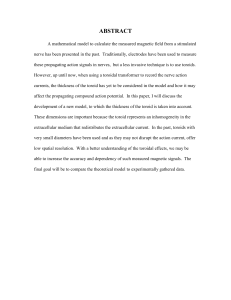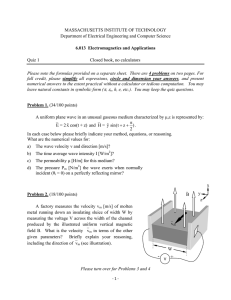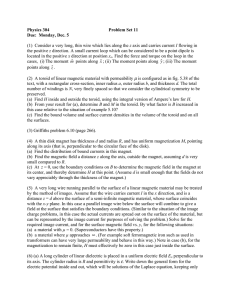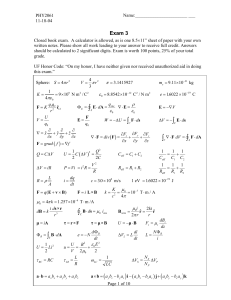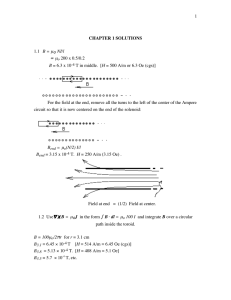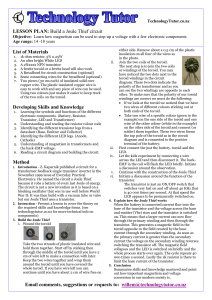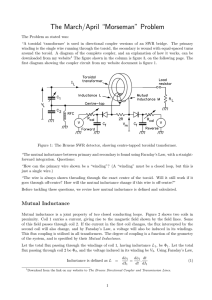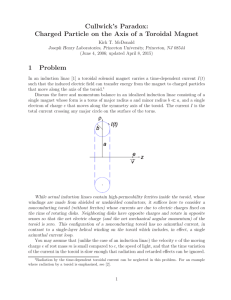Toroid`s self inductance
advertisement
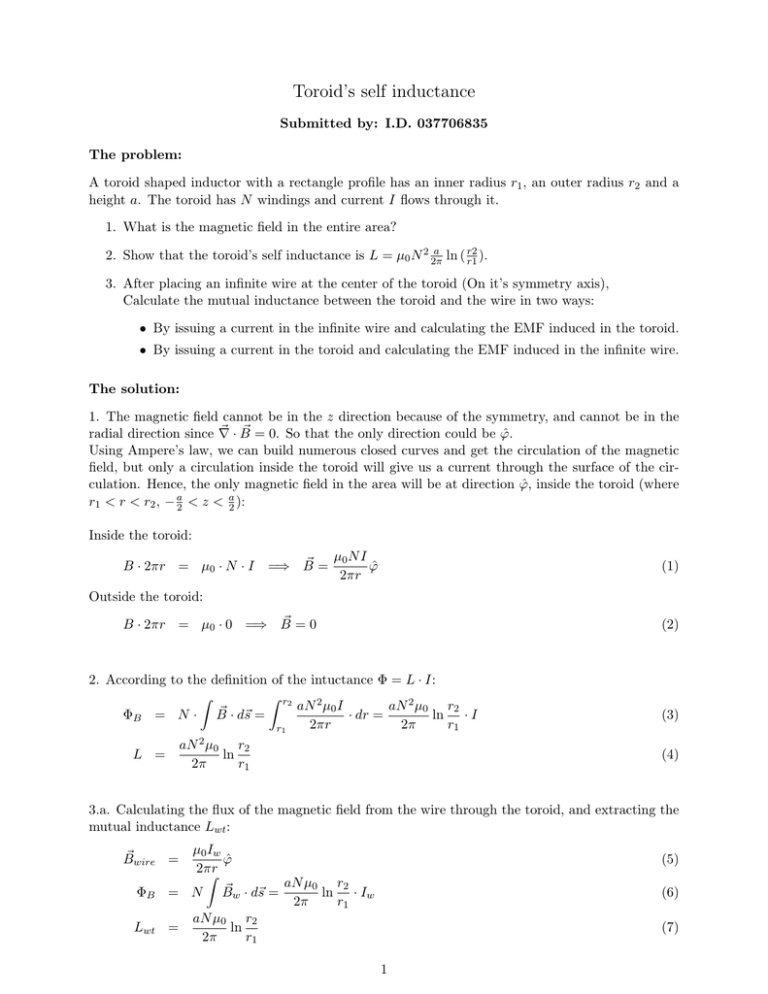
Toroid’s self inductance Submitted by: I.D. 037706835 The problem: A toroid shaped inductor with a rectangle profile has an inner radius r1 , an outer radius r2 and a height a. The toroid has N windings and current I flows through it. 1. What is the magnetic field in the entire area? a 2. Show that the toroid’s self inductance is L = µ0 N 2 2π ln ( r2 r1 ). 3. After placing an infinite wire at the center of the toroid (On it’s symmetry axis), Calculate the mutual inductance between the toroid and the wire in two ways: • By issuing a current in the infinite wire and calculating the EMF induced in the toroid. • By issuing a current in the toroid and calculating the EMF induced in the infinite wire. The solution: 1. The magnetic field cannot be in the z direction because of the symmetry, and cannot be in the ~ ·B ~ = 0. So that the only direction could be ϕ̂. radial direction since ∇ Using Ampere’s law, we can build numerous closed curves and get the circulation of the magnetic field, but only a circulation inside the toroid will give us a current through the surface of the circulation. Hence, the only magnetic field in the area will be at direction ϕ̂, inside the toroid (where r1 < r < r2 , − a2 < z < a2 ): Inside the toroid: B · 2πr = µ0 · N · I ~ = µ0 N I ϕ̂ =⇒ B 2πr (1) Outside the toroid: ~ =0 B · 2πr = µ0 · 0 =⇒ B (2) 2. According to the definition of the intuctance Φ = L · I: Z Z r2 aN 2 µ0 I aN 2 µ0 r2 ~ ΦB = N · B · d~s = · dr = ln · I 2πr 2π r1 r1 aN 2 µ0 r2 ln 2π r1 L = (3) (4) 3.a. Calculating the flux of the magnetic field from the wire through the toroid, and extracting the mutual inductance Lwt : µ0 Iw ϕ̂ 2πr Z ~ w · d~s = aN µ0 ln r2 · Iw = N B 2π r1 aN µ0 r2 = ln 2π r1 ~ wire = B ΦB Lwt (5) (6) (7) 1 3.b. Using Faraday’s law, and circulating on an infinite rectangle, where one of the sides is on the infinite wire, and the other three ones are far enough to assume that the electrical field in their area vanishes, we get that the circulation of the electrical field on the rectangle is equal to the EMF in the wire, hence: I Z ~ · d~l = − ∂ ~ · d~a = E B (8) ∂t Z r2 aµ0 N It aµ0 N r2 ˙ ∂ ∂ aµ0 N It r2 =− (9) = − dr = − ln ln · It ∂t r1 2πr ∂t 2π r1 2π r1 aN µ0 r2 Ltw = (10) ln 2π r1 And we got Lwt = Ltw as expected. Another method is using the differential version of Faraday’s law, taking under consideration that along the wire (at the area of the toroid, since only there a magnetic flux changes) there is an electrical field in the ẑ direction (cylindrical coordinates) which has no dependence on ϕ since the problem is symmetrical: ~ = µ0 N I · ϕ̂ B 2πr ~ ~ = − ∂ E · ϕ̂ = − ∂ B ∇×E ∂r ∂t Z ∂ ~ = ~ · dr E B ∂t Z Z a Z r2 2 aN µ0 r2 ∂ µ0 N I ~ = E · d~z = drdz = ln ( )I˙ ∂t − a r1 2πr 2π r1 ~ = E(r,z) ẑ E (11) (12) (13) (14) 2 Ltw = aN µ0 r2 ln 2π r1 (15) 2
